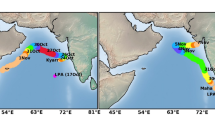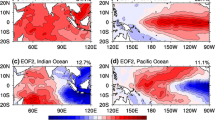Abstract
This study explores the background atmospheric conditions that led to the development of recent two sets of twin tropical cyclones in the Indian Ocean. One set of twins formed in late December 2011 (“pair A”) and other in May 2013 (“pair B”). An extensive area of active convection prevailing over wide-equatorial region and low-level westerly wind over near-equatorial region is major precursors to the two cases of twins. Convection and accompanying westerlies slowly strengthen, and the two sets of twins tend to emerge within it. The atmospheric equatorial convectively coupled Kelvin wave (CCKW) and convectively coupled equatorial Rossby (CCER) wave played key role in the formation of the two twins’ events. Wave-enhanced equatorial convection and low-level westerly anomalies produced by the combination of CCKW and CCER wave are crucial for the development of “pair A” twins. CCKW prior to “pair B” twins produced convection and westerly anomalies over equatorial region. The equatorial westerlies are further modulated by CCER wave favoring twins of “pair B.” Moreover, convection reinforced by CCER wave in OLR aided occurrence of Northern Hemispheric cyclone of “pair A” and Southern Hemispheric cyclone of “pair B.” While the CCKW and CCER wave appear to be associated with the formation of the two twin cyclone cases, more thorough understanding of the mechanisms involved needs considerable attention in forthcoming research.






Similar content being viewed by others
References
Baxter S, Gottschalk J, Bell GD (2014) [The tropics] Tropical intraseasonal variability in “State of the Climate in 2013”. Bull Am Meteorol Soc 95:S83–S84
Bessafi M, Wheeler M (2006) Modulation of south Indian ocean tropical cyclones by the Madden–Julian oscillation and convectively-coupled equatorial waves. Mon Weather Rev 134:638–656. doi:10.1175/MWR3087.1
Ferreira RN, Schubert WN, Hack JJ (1996) Dynamical aspects of twin tropical cyclones associated with the Madden–Julian Oscillation. J Atmos Sci 53:929–945
Frank WM, Roundy PE (2006) The role of tropical waves in tropical cyclogenesis. Mon Weather Rev 134:2397–2417
Gottschalck J, Roundy PE, Schreck CJ III, Vintzileos A, Zhang C (2013) Large-scale atmospheric and oceanic conditions during the 2011-2012 DYNAMO field campaign. Mon Weather Rev 141:4173–4196
Harrison DE, Giese BS (1991) Episodes of surface westerly winds as observed from islands in the western tropical Pacific. J Geophys Res 96:3221–3237
IMD (2011) Very sever cyclonic storm “THANE” over the Bay of Bengal (25–31 December 2011): a report. http://www.rsmcnewdelhi.imd.gov.in/images/pdf/publications/preliminary-report/thane.pdf
IMD (2013) NWP report on cyclonic storm Mahasen over the Bay of Bengal (10–16 May 2013). www.imd.gov.in/section/nhac/dynamic/NWPMAHASEN13.pdf
JTWC (2012) Annual tropical cyclone report 2012. http://www.usno.navy.mil/NOOC/nmfc-ph/RSS/jtwc/atcr/2012atcr.pdf
JTWC (2013) Annual tropical cyclone report 2013. http://www.usno.navy.mil/NOOC/nmfc-ph/RSS/jtwc/atcr/2013atcr.pdf
Kalnay E, Kanamitsu M, Kistler R, Collins W, Deaven D, Gandin L, Iredell M, Saha S, White G, Woollen J, Zhu Y, Chelliah M, Ebisuzaki W, Higgins W, Janowiak J, Mo KC, Ropelewski C, Wang J, Leetmaa A, Reynolds R, Jenne R, Joseph D (1996) The NCEP/NCAR 40-year reanalysis project. Bull Am Meteorol Soc 77:437–471
Keen RA (1982) The role of cross-equatorial tropical cyclone pairs in the southern oscillation. Mon Weather Rev 110:1405–1416
Kiladis GN, Wheeler MC (1995) Horizontal and vertical structure of observed tropospheric Equatorial Rossby wave. J Geophys Res D11(100):22981–22997
Kiladis GN, Meehl GA, Weickmann KM (1994) Large-scale circulation associated with westerly wind bursts and deep convection over the western equatorial Pacific. J Geophys Res 99:18527–18544
Kiladis GN, Wheeler MC, Haertel PT, Straub KH, Roundy PE (2009) Convectively coupled equatorial waves. Rev Geophys 47:2243. doi:10.1029/2008RG000266
Lander MA (1990) Evolution of the cloud pattern during the formation of tropical cyclone twins symmetrical with respect to the equator. Mon Weather Rev 118:1194–1202
Liebmann B, Smith CA (1996) Description of a complete (interpolated) outgoing long wave radiation dataset. Bull Am Meteorol Soc 77:1275–1277
Liebmann B, Hendon HH, Glick JD (1994) The relationship between tropical cyclones of western Pacific and Indian Ocean and Madden-Julian oscillation. J Meteorol Soc Japan 72:401–412
Madden RA, Julian PR (1971) Detection of a 40-50 day oscillation in the zonal wind in the tropical Pacific. J Atmos Sci 28:702–708
Madden RA, Julian PR (1972) Description of global-scale circulation cells in the tropics with a 40-50 day period. J Atmos Sci 29:1109–1123
Maloney E, Hartmann D (2000a) Modulation of eastern north Pacific hurricanes by the Madden-Julian oscillation. J Clim 13:1451–1460
Maloney E, Hartmann D (2000b) Modulation of hurricane activity in the Gulf of Mexico by the Madden–Julian oscillation. Science 287:2002–2004
Moum JN, deSzoeke SP, Smyth WD, Edson JB, DeWitt HL, Moulin AJ, Thompsonpher EJ, Zappa CJ, Rutledge SA, Johnson RH, Christopher WF (2014) Air-sea interactions from westerly wind bursts during the November 2011 MJO in the Indian Ocean. Bull Am Meteorol Soc 95:1185–1199
Nitta T (1989) Development of a twin cyclone and westerly bursts using the initial phase of the 1986–87 E1Nino. J Meteorol Soc Japan 67:677–681
Nitta T, Motoki T (1987) Abrupt enhancement of convective activity and low-level westerly burst during the onset phase of 1986-1987 El Niño. J Meteorol Soc Japan 65:497–506
Schreck CJ, Molinari J (2009) A case study of an outbreak of twin tropical cyclones. Mon Weather Rev 137:863–875. doi:10.1175/2008MWR2541.1
Schreck CJ, Molinari J (2011) Tropical cyclogenesis associated with Kelvin waves and the Madden–Julian oscillation. Mon Weather Rev 139:2723–2734
Schreck CJ, Molinari J, Aiyyer A (2012) A global view of equatorial waves and tropical cyclogenesis. Mon Weather Rev 140:774–788
Shen BW, Tao WK, Lin YL, Laing A (2012) Genesis of twin tropical cyclones as revealed by a global mesoscale model: the role of mixed Rossby-gravity waves. J Geophys Res 117:D13114. doi:10.1029/2012JD017450
Straub KH, Kiladis GN (2002) Observations of a convectively coupled Kelvin wave in the eastern Pacific ITCZ. J Atmos Sci 59:30–53
Wheeler MC, Kiladis GN (1999) Convectively coupled equatorial waves: analysis of cloud and temperature in the wave-number-frequency domain. J Atmos Sci 56:374–399
Wheeler MC, Mcbride JL (2005) Australian-Indonesian monsoon. In: Lau WKM, Waliser DE (eds) Intraseasonal variability in the atmosphere-ocean climate system, 1st edn. Springer, London, pp 125–173
Wheeler MC, Kiladis GN, Webster PJ (2000) Large-scale dynamical fields associated with convectively coupled equatorial waves. J Atmos Sci 57:613–640
Yoneyama K, Zhang C, Long CN (2013) Tracking pulses of the Madden–Julian oscillation. Bull Am Meteorol Soc 94:1871–1891
Acknowledgments
We thank Director, Indian Institute of Tropical Meteorology (IITM), Pune, for the motivation and support. The IITM is funded by the Ministry of Earth Sciences (MoES), Government of India, New Delhi. Authors extend gratitude to Dr. Carl Schreck, NOAA’s National Climatic Data Center, Asheville, NC, USA, for help in extracting equatorial waves. This research is greatly benefited by extremely useful suggestions from Dr. Prasanth A. Pillai, scientist, IITM, Pune. We also appreciate helpful discussions with Dr. A. B. Parekh and Dr. S. Pokhrel, both scientist at IITM, Pune. We would like to thank two anonymous reviewers for their valuable and constructive comments, which have substantially improved the manuscript. Some of the figures are made using GrADS software. Thanks to Brian Doty of Center for Ocean Land Atmosphere, USA, for making GrADS package freely available. Equatorial wave modes are extracted and plotted using “The National Center for Atmospheric Research Command Language (version 6.1.2) [Software]” (2013). Boulder, Colorado: UCAR/NCAR/CISL/VETS. http://dx.doi.org/10.5065/D6WD3XH5. All the data sources are duly acknowledged. Acknowledgment is made of the NCEP reanalysis circulation, velocity potential and OLR data provided by the NOAA/OAR/ESRL PSD, Boulder, Colorado, USA.
Author information
Authors and Affiliations
Corresponding author
Rights and permissions
About this article
Cite this article
Mandke, S.K., Sahai, A.K. Twin tropical cyclones in the Indian Ocean: the role of equatorial waves. Nat Hazards 84, 2211–2224 (2016). https://doi.org/10.1007/s11069-016-2546-z
Received:
Accepted:
Published:
Issue Date:
DOI: https://doi.org/10.1007/s11069-016-2546-z




